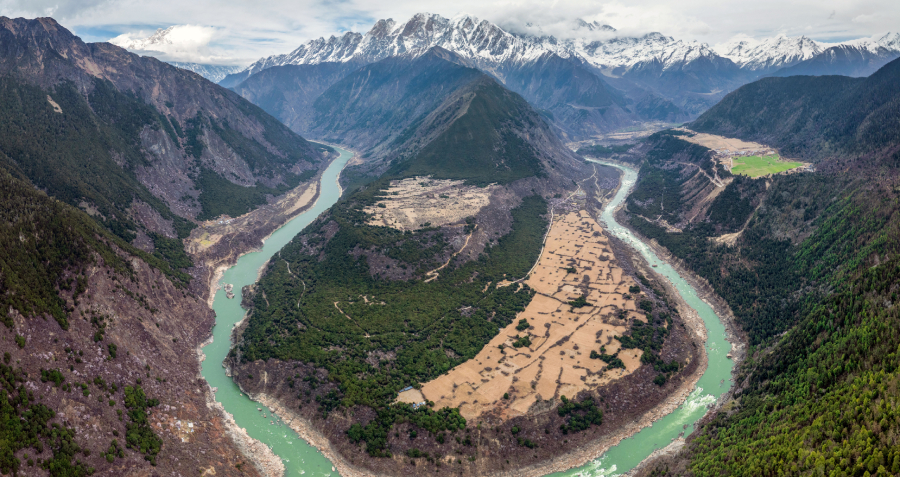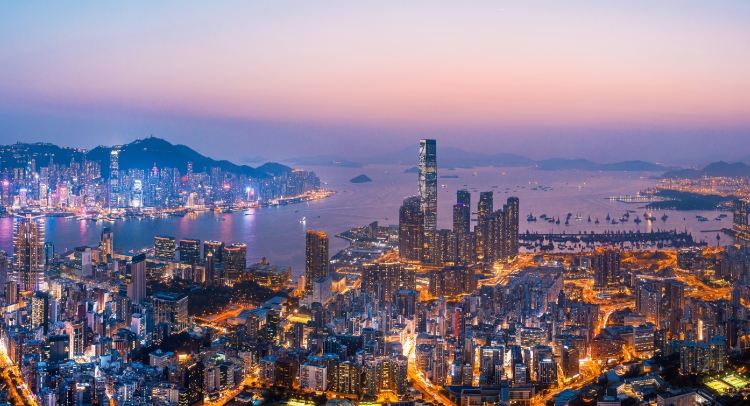In the remote northeastern foothills of the Himalayas, construction has been underway since July on what China has called its “project of the century”—a hydropower complex on the upper stretches of one of Asia’s longest rivers that will be the most powerful dam ever built worldwide and the latest show of Chinese political, economic and technological might.
The dam on the Yarlung Tsangpo river, as it is called in China, will provide a reliable supply of clean power that could give China a leg-up in achieving its climate goals while stimulating the economy. The project has surfaced anxieties about the geopolitics of water as Chinese control over the river—which becomes the Brahmaputra as it leaves Tibet and flows south into India and then into Bangladesh—could strain relations with New Delhi and Dhaka by strengthening Beijing’s leverage over downstream water flows into South Asia.
China’s leaders have underlined the importance of the project by including it in the 14th Five-Year Plan (FYP), sitting alongside other nation-building priorities such as the 1,629 km-long Sichuan-Tibet Railway, the BeiDou navigation satellite system and exploring other planets.
“There’s a multi-pronged reason why they want to do it. There’s the idea that it is simultaneously a technological leap, a stimulus plan and a major advance toward carbon neutrality,” says Ruth Gamble, lead author of Rivers of the Asian Highlands: from Deep-Time to the Climate Crisis and an environmental historian of Tibet, the Himalayas and Asia at La Trobe University.
Dam it
The sheer size of the dam is dizzying even in a country accustomed to colossal infrastructure projects. The undertaking is set to cost ¥1.2 trillion ($169 billion), a bigger price tag than building the International Space Station. Expected to enter commercial operations in 2033, it will have a potential installed capacity as high as 70 GW—dwarfing the Three Gorges Dam’s 22.5 GW and surpassing the total capacity of all China’s nuclear power stations currently in operation.
And the Yarlung Tsangpo’s Himalayan setting on the Tibetan Plateau sets the project apart from typical hydro dams like the Three Gorges, which simply block the path of a river to create a reservoir that is then released to drive turbines. The dam will block the river, but will also harness the immense latent hydropower from the Great Bend—a steep canyon where the Yarlung Tsangpo makes a horseshoe turn, then drops more than 2,000 metres over a 50 km stretch.
The published technical details indicate an audacious plan to bore a tunnel through the Himalayas to divert some of the river from going around the bend—instead it will flow through five cascading underwater hydropower stations within the tunnel.
Though the project’s scope is bold, it reflects an obsession with building dams and water management that has been cultivated over several millennia and now sits at the heart of Chinese statecraft.
“This is like no other dam that has been built before,” says Gamble. “The engineers in China are beyond world leaders—they’re 3D-printing dams at this point in the provinces of Yunnan and Sichuan. All of the accrued knowledge has paved the way for them to build this structure.”
The latest project has been on the drawing board for decades but Beijing’s approval at the end of last year was motivated by a combination of strategic, economic and political factors rather than by local energy demand, according to Sabrina Habich-Sobiegalla, co-editor of The Political Economy of Hydropower in Southwest China and Beyond.
“The economic gains matter most to the companies that build the dam, while for Beijing the project’s strategic and symbolic value is at least as important,” says Habich-Sobiegalla, who is a professor at Freie Universität Berlin’s Institute of Chinese Studies.
Huge dams have been central to planners’ thinking in previous economic cycles—for instance, the Three Gorges Dam was approved in 1992, when GDP clocked annual growth of 14-15%, and has since created supply chains that generate $57 billion of GDP every year.
The same applies here as the project will utilize some of the infrastructure capacity that is currently idle. But speculation that the dam could be economic stimulus in disguise seems misplaced, according to Hao Nan, a research fellow with the Charhar Institute, a foreign policy think tank in Beijing.
“It’s legitimate to ask if this is another stimulus move given the fact that the Chinese economy is slowing down, and that it already leveraged such stimulus in the Global Financial Crisis in 2008,” says Hao. “But my understanding… is the percentage of this investment in China’s total infrastructure investment is minimal, and also the economic projection of such a project to facilitate Chinese economic growth will also be minimal.”
Independent experts agree that the dam may provide only a modest boost to China’s economy—development could add just one-tenth of a percentage point to GDP for every year of construction, according to Capital Economics.
“Economic gains are certainly a major motivator, but they are most relevant for some of the actors involved rather than for the project as a whole,” says Habich-Sobiegalla. She notes that for state-owned hydropower companies, construction firms, and provincial governments, the dam represents contracts, jobs during the construction phase, and GDP growth figures that can be reported upwards—all of which bring tangible economic and political benefits.
For the central leadership in Beijing, however, Habich-Sobiegalla says the project is less to do with short-term profit and “more about meeting national renewable energy capacity targets, demonstrating engineering prowess, integrating Tibet more tightly into national infrastructure networks, and signalling political control in a sensitive frontier region.”
Profitability is unlikely to be a priority given the project underlines China’s technocratic governance. “The economics of it are very complicated because it has all of these flow-on effects. Breaking even is a nebulous concept when it comes to state infrastructure projects like these,” says Gamble. She points to the creation of a new state-owned enterprise, China Yajiang Group, that will direct both construction and operations: “if it fails, nobody’s going bankrupt—the state will just reabsorb it.”
Hydro hero
While the dam may not be directly about juicing the economy, it certainly aligns with the policy priority of China’s dual carbon goals of peaking carbon emissions before 2030 and then zeroing them out before 2060. Hydropower has been presented as a cornerstone of China’s decarbonization—the 14th FYP for Renewable Energy calls for hydropower to provide 17.4% of China’s electricity generation in 2025, up from 16% in 2021, while there is an official target to install 40 GW of new hydropower capacity in the 14th FYP period and again in the 15th FYP period covering 2026-2030.
“The dam is part of the vision of Tibet as a ‘clean energy supply base’ for the West-to-East Power Transmission programme. The electricity is not intended for local use, but for export to eastern provinces via ultra–high–voltage transmission lines,” says Habich-Sobiegalla.
At the same time, the most accessible and cost-effective dam sites in the southwestern provinces of Sichuan and Yunnan are already close to being fully exploited. The rivers of the Tibetan Plateau—especially the Yarlung Tsangpo—hold the last major untapped hydropower potential in China, estimated at more than 110 GW.
Once operational, the dam will generate enough clean electricity every year to satisfy the UK’s annual power demand. In theory, this will help China reduce its longstanding reliance on coal and contribute to climate targets. Hydropower also provides stable baseload power, which can complement the intermittency of wind and solar in the national grid.
The dam’s power output is earmarked to be transported over to the Yangtze River and Pearl River deltas, where China’s energy-intensive manufacturing industries are clustered, along with poorer western areas such as Tibet, where growth has long been held back by harsh terrain and limited resources.
The dam could also figure into the intensifying US-China rivalry over AI, as most data centers in China are located in the west of the country. “A determinative factor in this AI competition is going to be sourcing enough energy. This dam is going to produce electricity in the west that will then be consumed by the data centers in the West, so in that sense, it is definitely going to be beneficial for China’s AI pursuit,” says Hao.
The dam provides an opportunity for China to transform Tibet—which contributes a sliver of national GDP but is one of the fastest-growing provincial economies—into a regional development hub. “In terms of the Chinese development narrative, it has been left underdeveloped for a long time. Under Chinese governance logic, economic prosperity is something essential for political stability and so the dam aims to help shrink the disparity,” says Hao.
Dammed if you do
The scale of the project will require Beijing to strike a balance between exploiting what is considered the world’s most potent hydropower resource and preserving what is one of the last strongholds of Tibetan cultural and ecological integrity—a large area of which lies within the Qomolangma National Park. “Extracting energy but doing it without damaging the surrounding park—which is one of the world’s most biodiverse zones—is going to push Chinese engineering and technology right to the edge,” says Gamble.
The potential negative impacts are numerous. The reservoir built for the dam would submerge large tracts of intact forest, destroying habitats that are home to snow leopards, tigers and other endangered species. Construction would fragment ecosystems and potentially sever wildlife migration corridors in one of the most biodiverse regions of the Himalayas.
The dam would trap sediment, altering the natural flow of the Yarlung Tsangpo and affecting riverine and delta ecosystems far downstream. The location in a tectonically active zone means that landslides into the reservoir are likely, and the weight of the impounded water could trigger reservoir-induced seismic events. Finally, flooding vegetation at high altitude can release methane, offsetting part of the carbon benefit.
The geography of the project is also daunting, as the Great Bend canyon that China is looking to bypass by boring a tunnel is the site of both past megafloods and potential future flooding. Catastrophic floods over the millennia helped carve the region into the 6 km-deep gorge it is today. The canyon also lies near the epicentre of the 8.6-magnitude Assam-Tibet earthquake in 1950, one of the strongest ever recorded on land. “It’s an amazingly precarious place. Incredibly dynamic earthquakes, landslides, flooding—everything’s happening in that gorge,” says Gamble.
Geopolitics of water
Scrutiny over the project has come from both within China and outside. Domestically, environmental scientists and NGOs have repeatedly warned about the risks of building massive dams in seismically active and biodiverse regions. Such pressure has worked in the past—in 2016, the Chinese government ultimately canceled a planned series of 13 dams on the southwestern Nu River, ending a controversial project that was stalled multiple times over more than a decade.
“Although public debate on the dam project is more constrained, we have to assume unease among experts about its ecological and seismic risks,” says Habich-Sobiegalla.
Globally, environmental and human rights organizations are also active in raising awareness of the impacts. Tibetan advocacy groups emphasize the cultural and social consequences for local communities—including displacement, loss of traditional livelihoods and damage to sacred landscapes—while international NGOs have highlighted the biodiversity costs, pointing to the area’s status as one of the world’s richest high-altitude ecosystems.
Beyond the sizable engineering and environmental risks, the project could strain relations with two of China’s neighbors, India and Bangladesh. New Delhi and Dhaka have each expressed concerns that China’s upstream control could affect the quantity and timing of flows downstream, with consequences for agriculture, fisheries and flood management.
“The project has certainly given rise to concern and fears on the part of India and Bangladesh by the [Chinese] activities… upstream,” says Opangmeren Jamir, an associate fellow at the Manohar Parrikar Institute for Defence Studies and Analyses in New Delhi. He notes that from Beijing’s perspective, controlling the headwaters provides strategic leverage, even if the official narrative is framed in terms of clean energy and development.
As construction proceeds over the next several years, the dam is certain to leave a mark on the world, literally and figuratively. In the capitals of India, Bangladesh and elsewhere, the dam could become a persistent source of mistrust and a complicating factor in broader diplomatic and security relations with China. But that is unlikely to put a halt to the project, as it moves forward in another awe-inspiring monument to state-building.





















